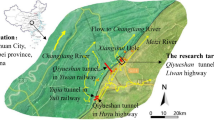Abstract
The groundwater seepage has an important effect on the stability of tunnel surrounding rock. Considering the effect of seepage, a hydro-mechanical coupling mathematical model is developed based on stress deformation equation of rock mass, flow equation of porous media and relation equation of hydro-mechanical coupling. In connection with the leakage situation of Jiangshuiquan Tunnel with super-large section, a geometry model of tunnel construction is built by COMSOL software platform. Furthermore, the hydro-mechanical coupling model is embedded in the PDE module of the software for numerical simulating the construction process of super-large section tunnel. Consequently, the surrounding rock displacement deformation under is discussed and verified by the data measured in field. Besides, the distribution characteristics of surrounding rock stress, seepage pressure and velocity are deeply analyzed. Results indicate that the displacement calculated by hydro-mechanical coupling model is well consistent with the site monitoring data and is greatly more than that of uncoupling model. After tunnel excavation, stress concentration phenomenon occurs around the cavern, especially at the arch foot part of the outer side wall, so the parts should be viewed as the key supporting part. The groundwater flows into the cavern and the surrounding pore water pressure is unloaded. A large hydraulic gradient occurs in the vault of the tunnel, prone to incur major engineering accidents; while the hydraulic gradient at vault is relatively small and usually has little harmful to engineering safety. The conclusion may provide guidelines for similar tunnel engineering construction.










Similar content being viewed by others
References
Bear J (1972) Dynamic of fluids in porous media. American Elsevier Pub. CO, New York
Hong KR (2017) Development and prospects of tunnels and underground works in China in recent two years. Tunn Constr 37(2):123–134
Ji XM, Wang YH, Yang ZY (2007) Hydromechanical coupling model and numerical simulation of tunnel excavation. Rock Soil Mech 28(S1):379–384
Ji YJ, Liu J, Cheng LS (2011) Numerical simulation of tunnel excavation considering fluid solid coupling. Rock Soil Mech 32(04):1229–1233
Kong XY (2010) Advanced seepage mechanics, 2nd edn. The China University of Science and Technology Press, Hefei
Lei XQ, Yang ZJ, He SM et al (2017) Hydro-mechanical analysis of rainfall-induced fines migration process within unsaturated soils. J Mt Sci 14(12):2603–2619. https://doi.org/10.1007/s11629-017-4359-2
Li WG, Yang Q (2018) Hydromechanical constitutive model for unsaturated soils with different overconsolidation ratios. Int J Geomech 18(2):04017142. https://doi.org/10.1061/(ASCE)GM.1943-5622.0001046
Li TC, Li SC, Chen WZ et al (2004) Coupled fluid-mechanical analysis of Xiamen subsea tunnel. Chin J Geotech Eng 26(03):397–401
Li PF, Zhang DL, Li B et al (2010) Coupled fluid-solid analysis of the surrounding rock stability of the subsea tunnel during construction process. Chin Railw Sci 31(03):35–41
Lisjak A, Kaifosh P, He L et al (2017) A 2D fully-coupled hydro-mechanical FDEM formulation for modelling fracturing processes in discontinuous, porous rock masses. Comput Geotech 81:1–18. https://doi.org/10.1016/j.compgeo.2016.07.009
Rutqvist J, Stephansson O (2003) The role of hydromechanical coupling in fractured rock engineering. Hydrogeol J 11:7–40
Simone DS, Carrera J (2017) Analytical solutions to coupled HM problems to highlight the nonlocal nature of aquifer storage. Water Resour Res 53:9580–9599. https://doi.org/10.1002/2017wr020824
Wang MS (2010) An overview of development of railways, tunnels and underground works in China. Tunn Constr 4:351–364
Wang RH, Zhang Q, Xia XZ (2017) Fully coupled modeling of fractured saturated porous medium using extended finite element method. Rock Soil Mech 38(05):1–9
Xing JT (2016) Developments of numerical methods for linear and nonlinear fluid–solid interaction dynamics with applications. Adv Mech 46:201602
Yan CZ, Jiao YY, Zheng H (2018) A fully coupled three-dimensional hydro-mechanical finite discrete element approach with real porous seepage for simulating 3D hydraulic fracturing. Comput Geotech 96:73–89. https://doi.org/10.1016/j.compgeo.2017.10.008
Yang ZQ, Ge KS, Li H (2016) Numerical simulation of excavation sequence of heading of single-tube double-deck tunnel based on solid–fluid coupling. Tunn Constr 36(10):1237–1244
Zienkiewicz OC, Taylor RL (2000) The finite element method, 5th edn. The Butterworth-Heinemann, Oxford
Acknowledgements
This work was financially supported by the National Natural Science Foundation of China (Grant Nos. 51679131, 51709159), the Key Research and Development Project of Shandong Province (Grant No. 2017GSF220014), the Postdoctoral Science Foundation of China (Grant Nos. 2017T100492, 2017M612273), the Special Foundation of Postdoctoral Innovation Project of Shandong Province (201702014), Open Foundation of State Key Laboratory for GeoMechanics and Deep Underground Engineering, China University of Mining and Technology (Grant No. SKLGDUE K1702), the CRSRI Open Research Program (Program SN: CKWV2018468/KY), and the Fundamental Research Funds of Shandong University (2016GN026). The authors would like to express appreciation to the editors and reviewers for their valuable comments and suggestions that helped to improve the quality of the paper.
Author information
Authors and Affiliations
Corresponding author
Rights and permissions
About this article
Cite this article
Liu, C., Li, S., Zhou, Z. et al. Numerical Analysis of Surrounding Rock Stability in Super-Large Section Tunnel Based on Hydro-Mechanical Coupling Model. Geotech Geol Eng 37, 1297–1310 (2019). https://doi.org/10.1007/s10706-018-0686-5
Received:
Accepted:
Published:
Issue Date:
DOI: https://doi.org/10.1007/s10706-018-0686-5




